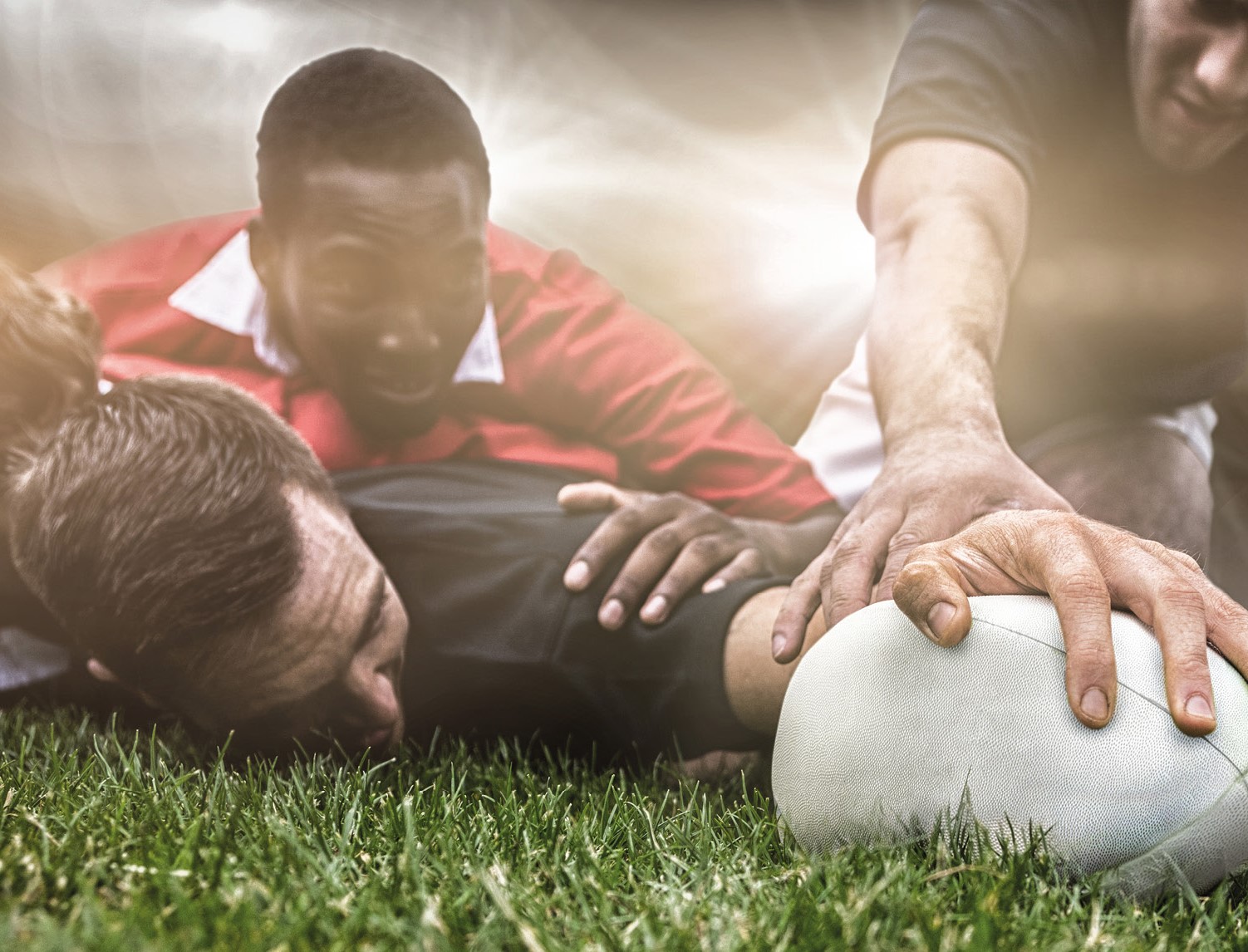Head injuries in contact sport: tackling a major issue
16th August 2021

A personal view from Legal Solutions Partner, Martin McAleer
Legend has it that a physiotherapist advised the great Brian Clough that one of his players had suffered a concussion while playing a match “… he doesn’t know who he is boss”. Mr Clough is alleged to have retorted “… tell him he’s Pele and to get on with the game”. In rugby union, the sport I played at mediocre amateur level at best and grew to love like no other, there were times when attitude to injury mirrored that of Monty Python’s Black Knight. Thankfully, I can actually remember the many times I insisted on going back on the pitch when injured or returning too soon after inadequate rehabilitation. Some don’t. I include head injuries in such archaic attitudes to injury but thankfully, certainly in the mini and junior rugby I remain involved in, I now see no evidence of any misplaced cavalier approach to head injury.
Avoiding, recognising and treating head injuries has been paramount in coaching and playing rugby for many years now, at all levels, and although football has some ground to cover yet, it is moving quickly in the right direction with the glaring exception of a few bewildering player returns to the pitch in Euro 2020. Player welfare is, or should be, front and centre in all contact sport.
But we have to question whether player welfare was always front and centre in contact sports. Did the sports we love do enough to protect players from avoidable head and brain injury? Were clubs and governing bodies aware of the risks of such injury and if so, did they do enough to protect their players? When it comes to the more complex and subtly nuanced diagnosis of dementia, can this be attributable to trauma and if so, can it be caused by one-off head impacts or by repetitive, often innocuous blows to the head?
The recent high profile claims brought by England’s Rugby World Cup winning hooker, Steve Thompson, and the decorated Welsh flanker Alix Popham, to name only two claimants, indicates there is widening clinical and legal opinion that it does. Families of former footballers who have died with dementia argue similarly – our most notable recent losses include Jack Charlton, Nobby Stiles and Gordon McQueen.
We could be forgiven for thinking that dementia – a horrific disease that progressively affects memory, emotions and the ability to socially interact – is linked only with natural ageing. The issue however, within a contact sports context, is whether dementia can be caused by an impact to the head, triggering rotational forces, stretching or shearing of the brain. Can such forces lead to brain inflammation and early onset dementia?
Equally questionable is whether Chronic Traumatic Encephalopathy (CTE) can be rooted in identical causes. These are all critical questions of causation that the high profile claim is trying to address. Undoubtedly, there is a growing body of neuropsychological, neurological and neuropathological opinion which concludes that repetitive impact to the head does lead to CTE and early onset dementia. In fact such expert opinion – and it must be said the research remains limited for now – concludes CTE is, on balance, related much more closely to repeated head trauma than any other degenerative neurological disorder.
So, causation is the first and probably more complex hurdle the claimants in the rugby test claims have to overcome. What precedent will they follow? Following the NFL test case led by “Iron Mike” Webster and the initially-scorned neuropathologist Dr Bennet Omalu, neither causation nor liability were admitted yet the NFL set aside a $765m war chest to meet Webster’s claim and subsequent claims made by NFL players. NFL player welfare was thereafter revolutionised. For example, contact or “hits” in training alone are said to have been reduced by 70,000 per player over the course of a career. Those changes to NFL regulations were introduced 10 years ago.
We may hear cries that rugby and football are different to the NFL and risks to players are much smaller, with fewer blows to the head, but that argument may not be sustainable. For example, protective equipment in both rugby and football is limited – though I’d query, for example, what protection a head guard would actually provide. In some quarters it is believed that up to 50% of all rugby players could have a neurological disorder due to repeated head trauma. Such a claim, if correct, is frightening at best but training is intense – a place in the starting team on Saturday is at risk – and players will try to impress selectors with their physicality.
On the above basis, is the causation argument stacked unfavourably against the governing bodies, Unions and clubs? In the face of the growing body of clinical opinion supporting the link between early onset dementia and CTE to head trauma sustained in contact sports, governing bodies, Unions and clubs will surely have to rely on neurological opinion which essentially concludes, on the balance of probabilities, repeated head trauma, innocuous or otherwise, causes neither disease. How big a task will that be?
The claimants in the rugby test claim have little obstacle to establishing a duty of care owed to them by World Rugby/ IRB, Unions and clubs, but establishing whether that duty was breached is difficult. Knowledge and timing are both critical. There is no doubt that currently the clubs, governing bodies and Unions are exhaustively trying to combat and eliminate head injuries from our sports. Potential claims and clear evidence of perhaps avoidable injuries are accelerating reforms and law changes which might just preserve the wonders of rugby.
The RFU will implement a two-fold trial in the junior game as of the season beginning September 2021:
• At U16 – U18 level, the legal height for tackling will be lowered to waist level
• The ball carrier will be penalised for late dipping of the head leading into the tackle – contact with the head is inevitably punished with the dreaded card but conceivably can blame at times be attributed to the ball carrier for late dipping?
Weight parity is another issue that could be looked at to preserve the game of rugby and reassure parents throughout the world. In New Zealand in November 2020, the Eden Lizards were crowned National U85kg Club Champions. A weight-restricted competition, at junior level, is a simple yet revolutionary (and surely workable) idea.
Who knows, if these trials succeed we may even see a faster off-loading game where the tackle is once again purely about technique and not size and power, and the unfortunate “size is everything” mantra will be lost for ever.
But did the RFU, other Unions/World Rugby/IRB and clubs act reasonably to implement similar and sufficient safety measures before the high-profile claimants brought the issues into much sharper focus? Were players at all levels properly protected? The issue is whether the clubs, Unions and governing bodies knew or ought to have known about the dangers and risks, what they did about such issues and whether such actions were enough to successfully defend an allegation of breach of duty.
Studies into concussions and head injuries sustained in sport have historically been inconclusive, in rugby in particular where studies go as far back as 1975, when at an IRB conference a three-week break from playing was recommended following a diagnosed concussion. Recommendations went further following an additional conference in 1992 when after a first concussion it was recommended players take a three-week break, after a second concussion it was recommended that the injured player should not play for the rest of that season and following a third concussion it was recommended a player should participate no further in the sport. It is difficult to say to what extent these recommendations were adequate and thereafter followed. The trouble is, such research, conclusions and recommendations may not have been widely accepted, presumably because of competing and inconclusive neurological opinion.
In view of these conflicting neurological views, did it suit the governing bodies, Unions and clubs to ignore recommendations to protect the commercial product (post-1995 professionalism in particular), or could/should they have done more? Were the decision makers properly equipped and advised to do more and did they put into place recommended and accepted safeguards? If not, then it is difficult to criticise. In the course of the high-profile claims by Thompson, Popham et al, one wonders if we will ever find out. What we can expect is enormous volumes of disclosure of documents trawling back over decades aimed at exploring just what World Rugby, the Unions and clubs actually knew or ought to have known and what was done to implement any safeguarding practices. Success or failure of these claims may well hinge on such historic issues.
Whilst research and investigation of causation and breach of duty are ongoing with huge intensity, what we can say with some certainty is that the sports of rugby and football are changing forever. We should not lose sight of the stated primary aim of Thompson, Popham et al which is to improve safety for participants in the game they still love. Long before – and in the wake of – these claims, contact training has been restricted; tackle laws are constantly under review and any head contact in rugby almost always sees red.
A key question is whether such measures were introduced early enough – proactively or reactively? Such improvements in safety must apply equally, perhaps even more, to the women’s game. Women’s rugby is a rapidly growing sport with over two million participants. At the highest level it is also played professionally by elite athletes. Training load is no less demanding but women are twice as likely to suffer concussion. The research and medical academia focus on the men’s game. If the emerging science is correct, the focus must be redirected upon the women’s game too. In football, children are restricted from heading the ball, and the FA is sitting up and taking notice of the increasing claims that its sport has caused dementia, but again are these measures too late and are they enough?
Safety in rugby and contact sport has been paramount for many years but has it been for long enough to avoid successful claims by former players who may have developed CTE and early onset dementia? There are so many unanswered questions but the claims brought by Thompson, Popham et al have brought safety and player welfare in all contact sports into even sharper focus. We are in the relatively early stages of that process and so cannot predict a conclusion. But what we can predict with some certainty is that the contact sports we know and love are changing, and like virtually every facet of our lives since COVID-19 engulfed our world, the future will be guided by the science.
Hot off the press this month is news of changes by World Rugby to the laws of the game next season to ameliorate the risk of injury by reducing the number of scrums and the nature and level of impact at the breakdown.
And in the last week, the Department for Culture, Media and Sports has published a report highlighting how serious the issue is being taken at a Government level. The report recognises that perhaps self-regulation by sports’ own Unions and Associations has historically fallen short and urges the Government to “grasp the nettle” and join in taking “real and effective action”. The recommended over-arching concussion protocol, among other robust recommendations, should begin to point our sports in the right direction when recognising and reducing head injuries. The report does not quite directly link contact sport with dementia, yet concludes a minority of participants face long-term neurological issues. Perhaps unsurprisingly the issue of causation is to be left for judicial input.
If you would like more information, get in touch with Legal Solutions Partner, Martin McAleer at mmcaleer@keoghs.co.uk.
Related Articles
-
- Article
- Legal Solutions
Search engine ad spoofing: is the Online Safety Bill the solution?
The issue When an accident takes place, the first thing that…
-
- Article
- Legal Solutions
Allianz and LV= GI reappoint Keoghs as strategic partner
Following a comprehensive market review, our legal solutions team Keoghs has…
-
- Article
- Claims Solutions
- Legal Solutions
Preparing for the long anticipated whiplash reforms
This article was first published by Insurance Times The government’s whiplash…
-
- Article
- Legal Solutions
Davies announces appointment of CEO & CCO for its legal solutions business Keoghs
LONDON, UK – 25 March 2021 – Davies, the leading specialist…



